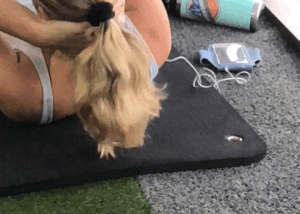
Hair that grows ON the nose is actually quite normal, but there are a few great ways to get rid of this unattractive hair growth.
Do not be alarmed if you’ve recently noticed that a lot of hair has been growing ON your nose.
Why shouldn’t it? After all, skin has hair follicles. Your nose is covered in skin.
For some people, the growth of hair on their nose is more obvious than that in other individuals.
In fact, it’s been said that the human face has as many hair follicles as the face of a lower primate.
It’s just that the hairs of our foreheads, cheeks and nose are very light, fine and short.
And some people end up having darker hair on their nose, making it more visible.
Very fine, “peach fuzz” hair on the nose (and face) is called vellus hair.
Get Rid of Hair on the Nose
There are options far better than that of using a plastic shaver that’s designed for the legs or a man’s facial contours.
And you certainly do not want to pluck at the hairs with a tweezer.
This will hurt and it’ll take forever to get enough hairs to make a difference. Plus, you’ll have to keep redoing this task every several days.
Furthermore, some hairs, though visible, will always be too short to pluck out.
Better Ways…
“Waxing and Biore Clay pore strips are excellent options for removing unwanted nasal hairs, blackheads and whiteheads,” says Estee Williams, MD, a board certified medical, cosmetic and surgical dermatologist and assistant clinical professor in dermatology at Mount Sinai Medical Center.
Waxing the nose can be done at home, but you’ll get better results having a professional aesthetician do the job.
Give the Biore pore strips a try. First wet your nose. Then peel a strip off the plastic and apply to your nose.
Leave on for 10 to 15 minutes. Then peel off the strip starting at its edges.
If the hairs aren’t removed, your nose will still benefit from the deep cleansing action to the pores, which should last three weeks.
Dermaplaning to Rid Hair on the Nose
A trained professional uses a sterile, surgical-grade blade to gently scrape the surface of the skin.
This process removes the top layer of dead skin cells and fine, thin hairs.
While professional dermaplaning is often recommended for the best results and to ensure safety, there are also at-home dermaplaning tools available — which will cost a lot less than what a professional would charge.
If you choose to do it yourself, be cautious to avoid cutting or irritating the skin.

Dr. Williams strives to be at the forefront of her field, being active in local, national and international medical and cosmetic dermatology conferences.
 Lorra Garrick has been covering medical, fitness and cybersecurity topics for many years, having written thousands of articles for print magazines and websites, including as a ghostwriter. She’s also a former ACE-certified personal trainer.
Lorra Garrick has been covering medical, fitness and cybersecurity topics for many years, having written thousands of articles for print magazines and websites, including as a ghostwriter. She’s also a former ACE-certified personal trainer.
.









































